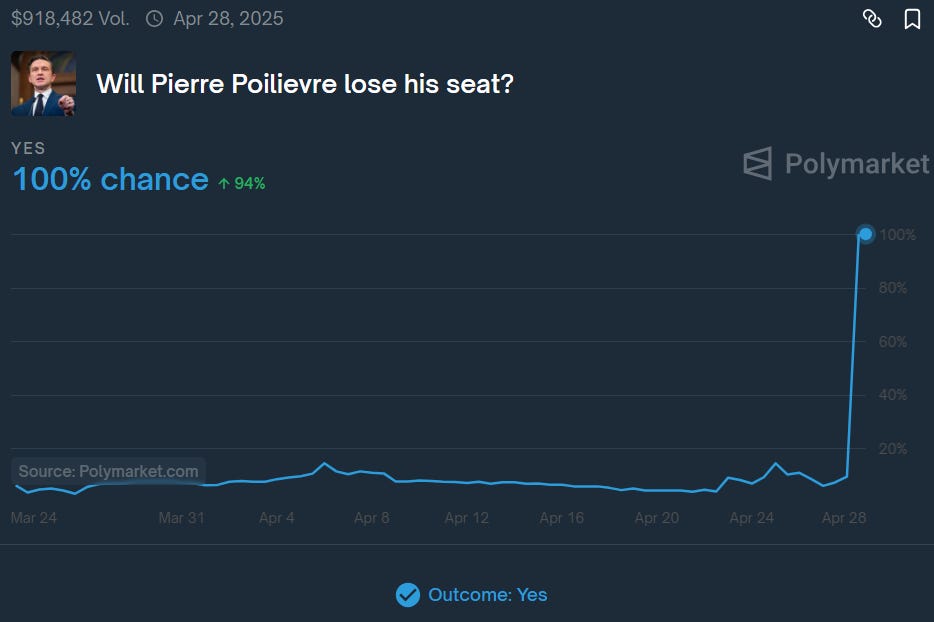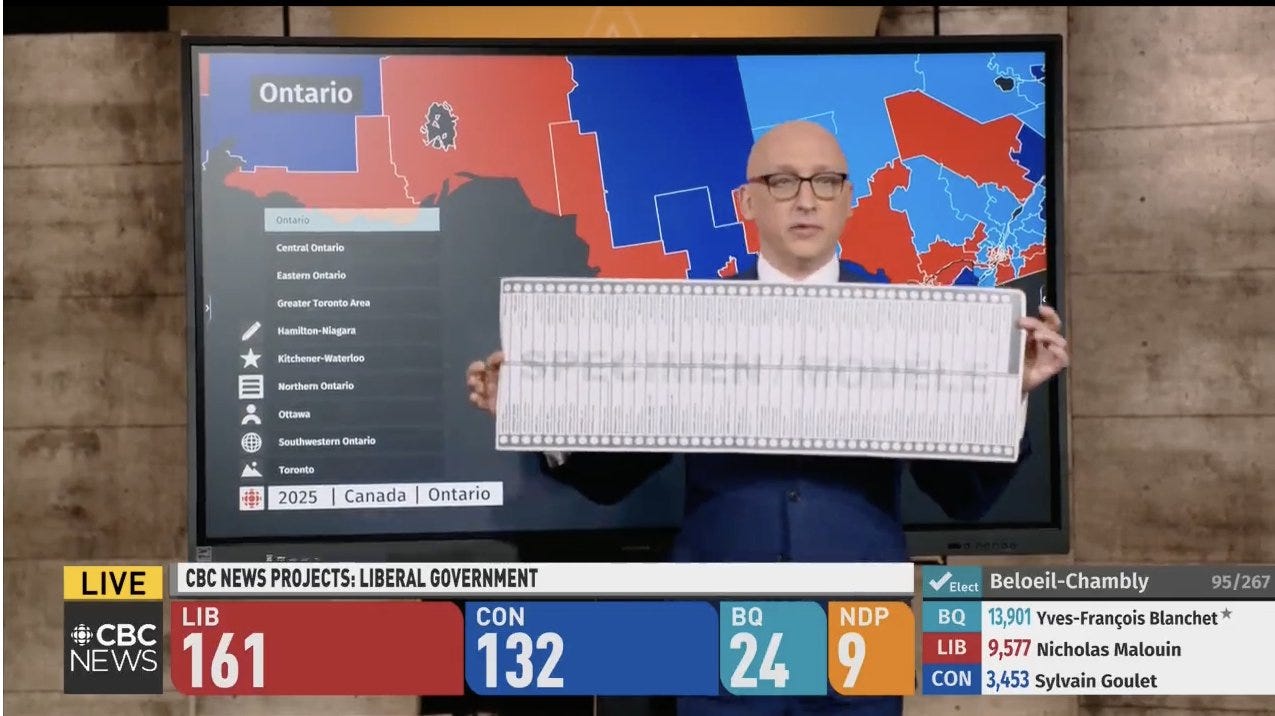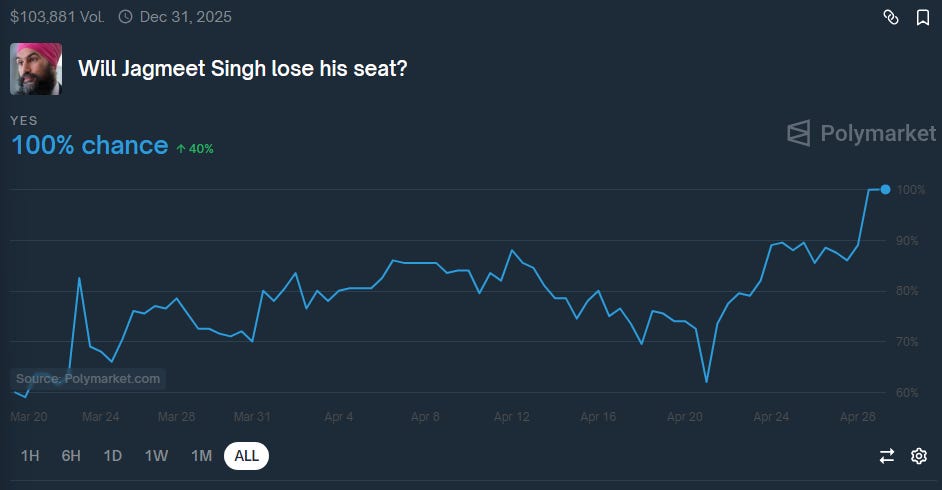🔮 It’s Carney
How Polymarket Performed on Canada’s Big Night
By Napas Thein
Heading into election night, Carney led the Polymarket odds with a 70–80% chance of taking the Liberals across the finish line. After polls closed in Atlantic Canada, Carney’s odds dipped as low as 52% at around 8 PM, as early Conservative strength spooked traders. But by the end of the night, Carney’s odds reverted to their original strength.
Who Called it Faster?
News networks have a practice of “calling” an election, ie. picking a single point in time where they believe it’s a done deal.
With Polymarket, you get a continuous flow of updated odds as traders price in new information in real time. This lets you pick your own threshold for “I’ve seen enough.”
How Poilievre Blew a 9:1 Lead
In January 2025, Conservative leader Pierre Polievre’s odds hit a high of 92% before their steady decline to last night’s result. What happened?
Poilievre's early success hinged on the declining popularity of former Prime Minister Justin Trudeau, including a carbon tax which was imposed in 2019 and continually increased despite affordability concerns.
But Polievere’s odds truly began to nosedive following Trump’s inauguration and tariffs on Canadian goods. After Trudeau’s resignation, Poilievre failed to adapt to the new political environment which focused on Trump and couldn’t shake associations his right wing movement had with the US.
Majority or Minority?
But election night was not without surprises.
Heading into the election, chances for a Liberal majority government were 56-58% on Polymarket.
However, as votes were counted across the country, those odds plummeted, instead giving the Liberals a 96% chance at a minority government.
But in this case Polymarket was Less Wrong™ than the CBC’s forecast, which put the Liberal majority at 70% on the eve of the election.
As of this morning, the Liberals are projected to hold 168 ridings, just shy of the 172 seats needed for a majority. If these projections hold, Liberals can maintain their position in Parliament either by getting support from the Conservatives, the Bloc Quebecois, or the NDP. If these parties agree they can vote to bring down the government and push forward another election.
Seatless Opposition Leader
Another surprise was Poilievre’s devastating defeat on his home turf of Carleton.
The odds of Poilievre losing his seat were very low before election day, hovering around 6-9% until the results began to roll in.
Here, the market seemed to be discounting reporting from the day before from both parties’ internal polling that showed a substantial advantage for the Liberals.
One X-factor was that Poilievre faced 90 competitors in his riding, leading to a ridiculously long ballot for voters to navigate. This was part of a protest movement by a group known as the Longest Ballot, who sought to flood the zone with candidates in an effort to purposefully complicate the process.
It is unclear what losing his seat would mean for Poilievre's role as opposition leader, as not having a seat greatly limits his ability to speak in the House. That said, Poilievre committed to remaining as leader in his concession speech and continuing the fight.
His odds of resignation this year have increased to 🔮 63%.
Seatless Socialists
Left-wing NDP leader Jagmeet Singh suffered a devastating defeat on both the national and local levels. In his own riding, Singh’s vote share fell to third place. In his concession speech, he resigned as leader of the New Democratic Party.
This matched the Polymarket odds prior to the election which put him losing his seat at around 89%. National support has cratered so severely that the NDP is likely not going to reach the 12-seat threshold for official party status after the election.
This would be a dramatic fall for a party that once aspired to lead the country. Ironically, Conservatives might not celebrate the NDP’s collapse—without the NDP siphoning off left-leaning votes, the Liberals could consolidate the center-left and maintain a stronger hold on power.
What’s Next?
During the campaign, opposition to Trump dominated Canadian politics, pushing the two major parties together on many issues. Still, a number of themes emerged from last night’s results:
Young Voters Swing Right. Historically, Canadian youth have voted heavily Liberal or NDP. But this time, younger Canadians, especially young men, shifted toward Conservatives. Why? Housing affordability has become a crushing burden, youth unemployment remains high, and the promise of left-leaning policies has rung hollow.
Energy Investments. Both parties are backing the creation of a one-stop federal office to streamline approvals for significant energy and natural resource projects. The goal? Strengthen Canada's development capacity by cutting red tape and speeding up projects.
Reciprocal Tariffs. Both parties took a tough stance against Trump. They’ve pledged reciprocal tariffs in response to any American trade aggression and signaled a more rigid negotiating posture toward the future of the USMCA (or CUSMA in Canadian terms). Protecting Canadian sovereignty—economically and politically—has become a bipartisan theme.
Getting to 2% Defense Spending. Liberals have also aligned closely with Conservatives on military spending, pledging to finally meet NATO’s 2% of GDP defense target—a goal unmet by any Canadian government in decades.
Connect With The Oracle
Tips? Feedback? Story ideas? Write oracle@polymarket.com or @wasabiboat on X
Write for The Oracle: We’re expanding our coverage and looking to hire more writers and investigators. Details Here.
Disclaimer
Nothing in The Oracle is financial, investment, legal or any other type of professional advice. Anything provided in any newsletter is for informational purposes only and is not meant to be an endorsement of any type of activity or any particular market or product. Terms of Service on polymarket.com prohibit US persons and persons from certain other jurisdictions from using Polymarket to trade, although data and information is viewable globally.













This is plausible. It almost sounded overrated but likely and possibly true....this is quite heart racing
same as the lastguy wef netzero guy justa batonhandover